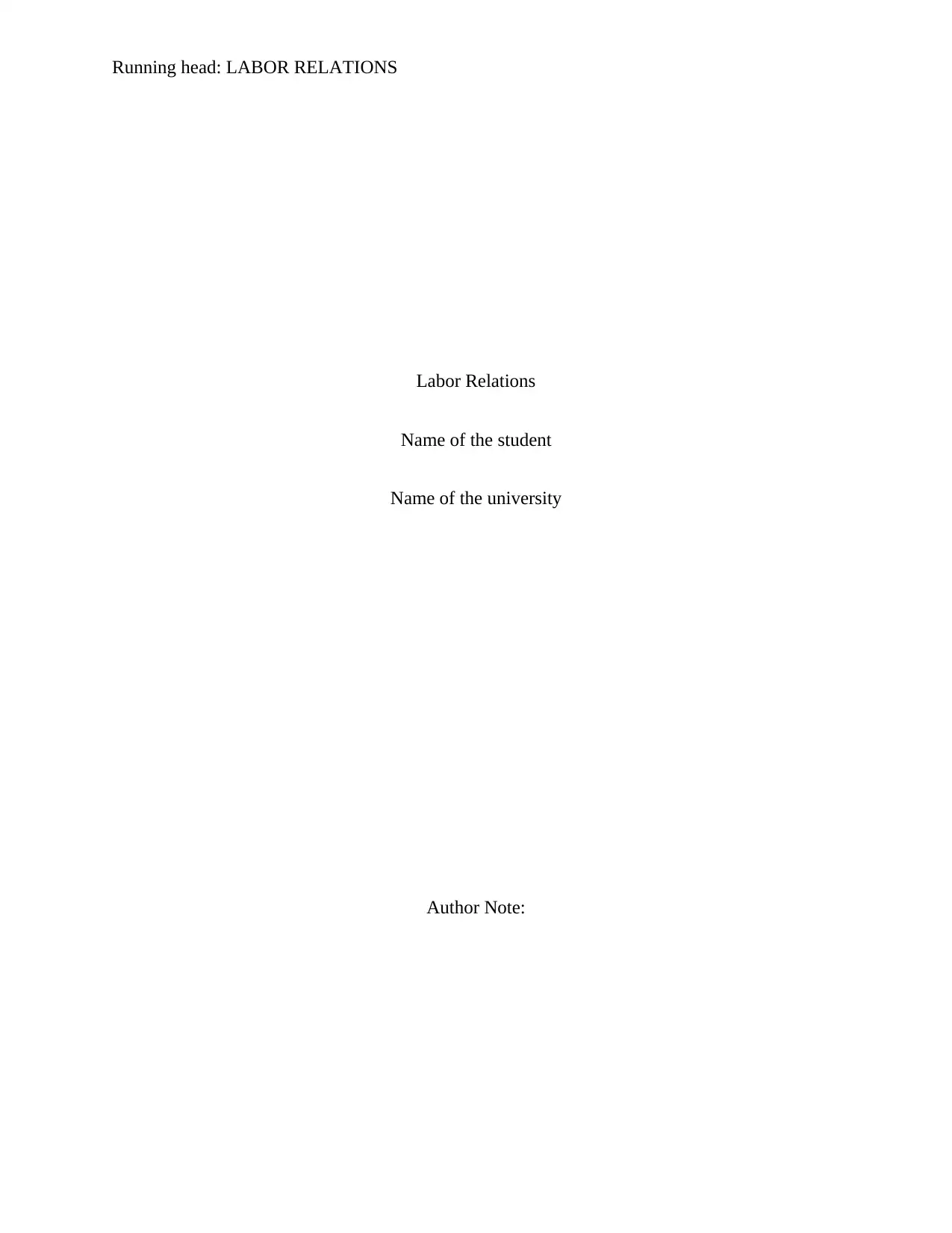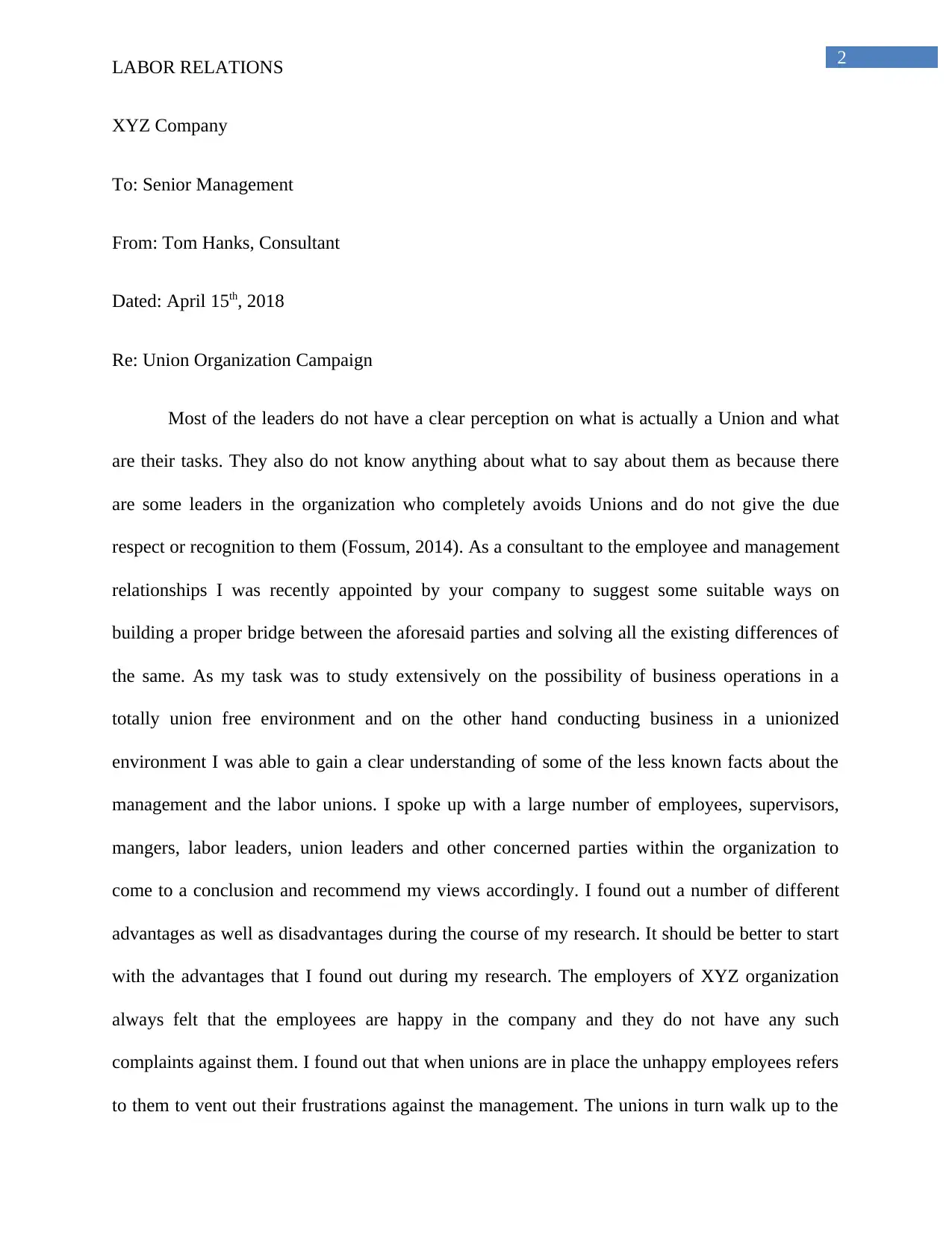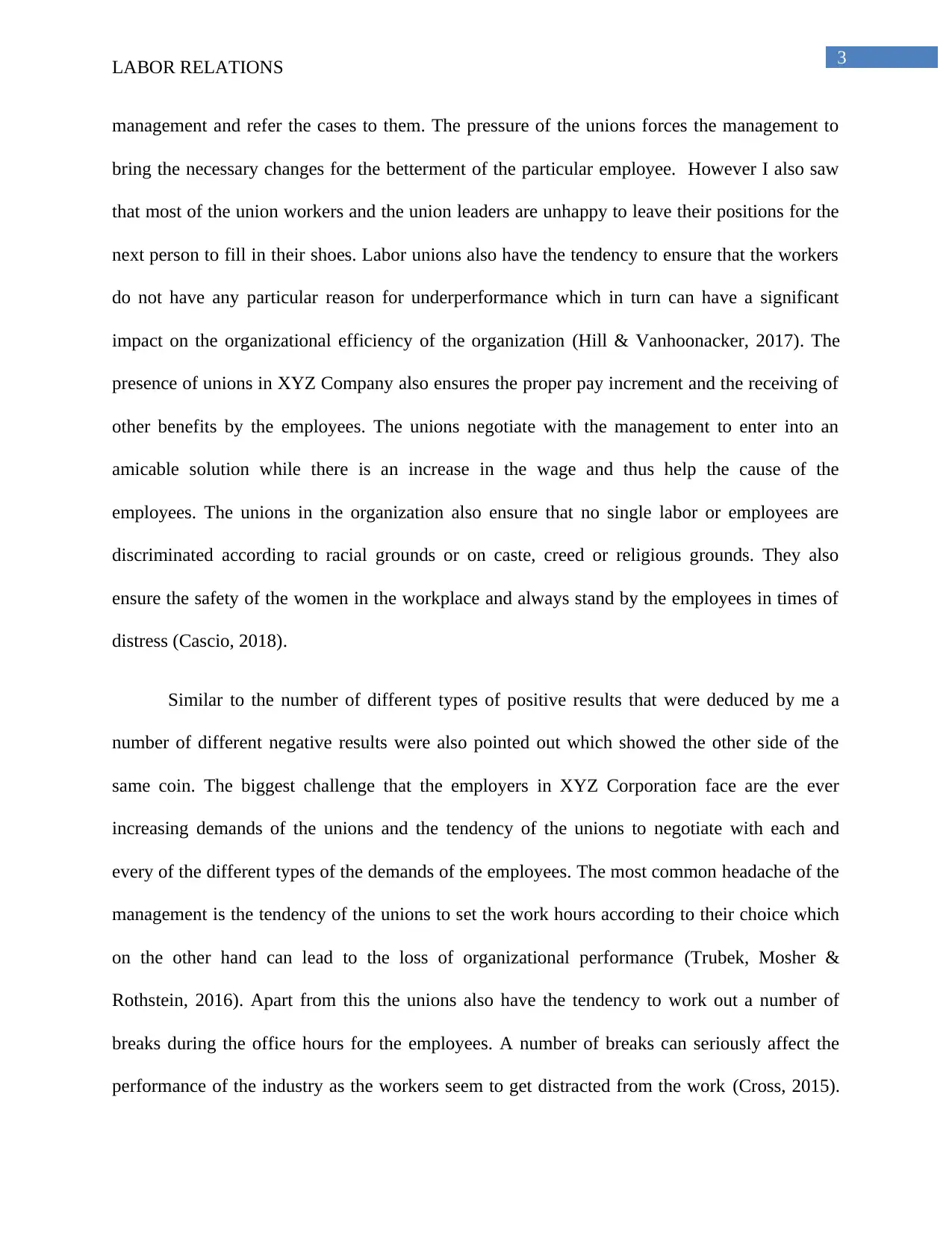Labor Relations: Advantages and Disadvantages of Unionization in XYZ Company
VerifiedAdded on 2023/06/13
|5
|1059
|480
AI Summary
This article discusses the advantages and disadvantages of unionization in XYZ Company. It also provides recommendations on how to build a proper bridge between the management and labor unions.
Contribute Materials
Your contribution can guide someone’s learning journey. Share your
documents today.

Running head: LABOR RELATIONS
Labor Relations
Name of the student
Name of the university
Author Note:
Labor Relations
Name of the student
Name of the university
Author Note:
Secure Best Marks with AI Grader
Need help grading? Try our AI Grader for instant feedback on your assignments.

2
LABOR RELATIONS
XYZ Company
To: Senior Management
From: Tom Hanks, Consultant
Dated: April 15th, 2018
Re: Union Organization Campaign
Most of the leaders do not have a clear perception on what is actually a Union and what
are their tasks. They also do not know anything about what to say about them as because there
are some leaders in the organization who completely avoids Unions and do not give the due
respect or recognition to them (Fossum, 2014). As a consultant to the employee and management
relationships I was recently appointed by your company to suggest some suitable ways on
building a proper bridge between the aforesaid parties and solving all the existing differences of
the same. As my task was to study extensively on the possibility of business operations in a
totally union free environment and on the other hand conducting business in a unionized
environment I was able to gain a clear understanding of some of the less known facts about the
management and the labor unions. I spoke up with a large number of employees, supervisors,
mangers, labor leaders, union leaders and other concerned parties within the organization to
come to a conclusion and recommend my views accordingly. I found out a number of different
advantages as well as disadvantages during the course of my research. It should be better to start
with the advantages that I found out during my research. The employers of XYZ organization
always felt that the employees are happy in the company and they do not have any such
complaints against them. I found out that when unions are in place the unhappy employees refers
to them to vent out their frustrations against the management. The unions in turn walk up to the
LABOR RELATIONS
XYZ Company
To: Senior Management
From: Tom Hanks, Consultant
Dated: April 15th, 2018
Re: Union Organization Campaign
Most of the leaders do not have a clear perception on what is actually a Union and what
are their tasks. They also do not know anything about what to say about them as because there
are some leaders in the organization who completely avoids Unions and do not give the due
respect or recognition to them (Fossum, 2014). As a consultant to the employee and management
relationships I was recently appointed by your company to suggest some suitable ways on
building a proper bridge between the aforesaid parties and solving all the existing differences of
the same. As my task was to study extensively on the possibility of business operations in a
totally union free environment and on the other hand conducting business in a unionized
environment I was able to gain a clear understanding of some of the less known facts about the
management and the labor unions. I spoke up with a large number of employees, supervisors,
mangers, labor leaders, union leaders and other concerned parties within the organization to
come to a conclusion and recommend my views accordingly. I found out a number of different
advantages as well as disadvantages during the course of my research. It should be better to start
with the advantages that I found out during my research. The employers of XYZ organization
always felt that the employees are happy in the company and they do not have any such
complaints against them. I found out that when unions are in place the unhappy employees refers
to them to vent out their frustrations against the management. The unions in turn walk up to the

3
LABOR RELATIONS
management and refer the cases to them. The pressure of the unions forces the management to
bring the necessary changes for the betterment of the particular employee. However I also saw
that most of the union workers and the union leaders are unhappy to leave their positions for the
next person to fill in their shoes. Labor unions also have the tendency to ensure that the workers
do not have any particular reason for underperformance which in turn can have a significant
impact on the organizational efficiency of the organization (Hill & Vanhoonacker, 2017). The
presence of unions in XYZ Company also ensures the proper pay increment and the receiving of
other benefits by the employees. The unions negotiate with the management to enter into an
amicable solution while there is an increase in the wage and thus help the cause of the
employees. The unions in the organization also ensure that no single labor or employees are
discriminated according to racial grounds or on caste, creed or religious grounds. They also
ensure the safety of the women in the workplace and always stand by the employees in times of
distress (Cascio, 2018).
Similar to the number of different types of positive results that were deduced by me a
number of different negative results were also pointed out which showed the other side of the
same coin. The biggest challenge that the employers in XYZ Corporation face are the ever
increasing demands of the unions and the tendency of the unions to negotiate with each and
every of the different types of the demands of the employees. The most common headache of the
management is the tendency of the unions to set the work hours according to their choice which
on the other hand can lead to the loss of organizational performance (Trubek, Mosher &
Rothstein, 2016). Apart from this the unions also have the tendency to work out a number of
breaks during the office hours for the employees. A number of breaks can seriously affect the
performance of the industry as the workers seem to get distracted from the work (Cross, 2015).
LABOR RELATIONS
management and refer the cases to them. The pressure of the unions forces the management to
bring the necessary changes for the betterment of the particular employee. However I also saw
that most of the union workers and the union leaders are unhappy to leave their positions for the
next person to fill in their shoes. Labor unions also have the tendency to ensure that the workers
do not have any particular reason for underperformance which in turn can have a significant
impact on the organizational efficiency of the organization (Hill & Vanhoonacker, 2017). The
presence of unions in XYZ Company also ensures the proper pay increment and the receiving of
other benefits by the employees. The unions negotiate with the management to enter into an
amicable solution while there is an increase in the wage and thus help the cause of the
employees. The unions in the organization also ensure that no single labor or employees are
discriminated according to racial grounds or on caste, creed or religious grounds. They also
ensure the safety of the women in the workplace and always stand by the employees in times of
distress (Cascio, 2018).
Similar to the number of different types of positive results that were deduced by me a
number of different negative results were also pointed out which showed the other side of the
same coin. The biggest challenge that the employers in XYZ Corporation face are the ever
increasing demands of the unions and the tendency of the unions to negotiate with each and
every of the different types of the demands of the employees. The most common headache of the
management is the tendency of the unions to set the work hours according to their choice which
on the other hand can lead to the loss of organizational performance (Trubek, Mosher &
Rothstein, 2016). Apart from this the unions also have the tendency to work out a number of
breaks during the office hours for the employees. A number of breaks can seriously affect the
performance of the industry as the workers seem to get distracted from the work (Cross, 2015).

4
LABOR RELATIONS
The union workers do not take heed of the workload and display a carefree attitude which may
be harmful for the growth of the organization. The unions can also sometimes demand
unjustified needs like sudden increase of salary, threaten to destabilize work regime by calling
strikes and many more such unlawful activities.
I have recommended the measures in line with the study of Schmitter, Brunetta & Dell-
Arringa (2016). According to me it would be better to take a see first approach for the
management. It will be much wise for the organization to first hear the demands of the unions
and then take a careful approach. The management must also stop the regular outgoing of the
employees for breaks and must implement a strict policy of staying in the office for a minimum
of 8 hours irrespective of the breaks. The management can install biometric machines to make
sure that the time record of the office hours of the employees is kept in the records for the future
assessment.
LABOR RELATIONS
The union workers do not take heed of the workload and display a carefree attitude which may
be harmful for the growth of the organization. The unions can also sometimes demand
unjustified needs like sudden increase of salary, threaten to destabilize work regime by calling
strikes and many more such unlawful activities.
I have recommended the measures in line with the study of Schmitter, Brunetta & Dell-
Arringa (2016). According to me it would be better to take a see first approach for the
management. It will be much wise for the organization to first hear the demands of the unions
and then take a careful approach. The management must also stop the regular outgoing of the
employees for breaks and must implement a strict policy of staying in the office for a minimum
of 8 hours irrespective of the breaks. The management can install biometric machines to make
sure that the time record of the office hours of the employees is kept in the records for the future
assessment.
Paraphrase This Document
Need a fresh take? Get an instant paraphrase of this document with our AI Paraphraser

5
LABOR RELATIONS
References
Cascio, W. (2018). Managing human resources. McGraw-Hill Education.
Cross, J. (2015). Workshop Training: Collective Bargaining and Labor Relations for New
Administrators and Labor Representatives. Journal of Collective Bargaining in the
Academy, (10), 5.
Fossum, J. A. (2014). Labor relations. Mcgraw Hill Higher Educat.
Hill, C., & Vanhoonacker, S. (2017). International relations and the European Union. Oxford
University Press.
Schmitter, P. C., Brunetta, R., & Dell-Arringa, C. (2016). Labor Relations and Economic
Performance. Sectors in Modern Capitalism: Modes of Governance and Variation in
Performance, in.
Trubek, D. M., Mosher, J., & Rothstein, J. S. (2016). Transnationalism in the Regulation of
Labor Relations.
LABOR RELATIONS
References
Cascio, W. (2018). Managing human resources. McGraw-Hill Education.
Cross, J. (2015). Workshop Training: Collective Bargaining and Labor Relations for New
Administrators and Labor Representatives. Journal of Collective Bargaining in the
Academy, (10), 5.
Fossum, J. A. (2014). Labor relations. Mcgraw Hill Higher Educat.
Hill, C., & Vanhoonacker, S. (2017). International relations and the European Union. Oxford
University Press.
Schmitter, P. C., Brunetta, R., & Dell-Arringa, C. (2016). Labor Relations and Economic
Performance. Sectors in Modern Capitalism: Modes of Governance and Variation in
Performance, in.
Trubek, D. M., Mosher, J., & Rothstein, J. S. (2016). Transnationalism in the Regulation of
Labor Relations.
1 out of 5
![[object Object]](/_next/static/media/star-bottom.7253800d.svg)





